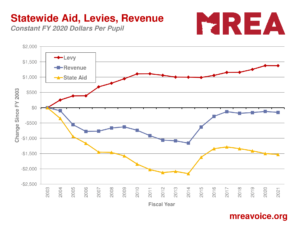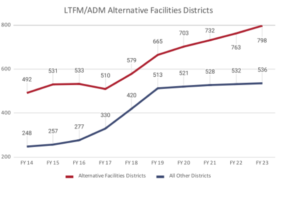Currently 93 percent of Minnesota’s 330 school districts receive less aid per pupil today than they did in 2003, when adjusted for inflation.
Projections based on current state law indicate a continued decline in real per pupil school aid through 2021, as shown on this graph.

LONG-TERM FACILITY MAINTENANCE
Long-Term Facility Maintenance (LTFM) funding is now frozen at $380 per adjusted pupil unit for school districts other than the largest districts, which are eligible for Alternative Facilities Funding. They continue to submit 10-year plans to the Minnesota Department of Education (MDE) for the maintenance of their buildings and then levy what they need.

As a result, the funding gap for rural schools is projected to grow to $262 per pupil in four years. LTFM is equalized at 123 percent of average Modified Adjusted Net Tax Capacity (ANTC) and eligible for Ag2School when districts bond against future LTFM revenue.
Enacted in 2015, LTFM helps school districts address their facility needs. The funding can be used for deferred capital expenditures, maintenance projects, increasing accessibility, improving health, safety and environmental management and voluntary PreK.
MREA advocated in 2015 to secure the new revenue and in 2018 to provide school districts greater flexibility in its uses. School districts in Minnesota saw a median increase of $214 per pupil in LTFM revenue.
Prior to this funding, there was a funding differential that led the state’s 25 largest school districts to spend an average of $2.79 per square foot while 314 other school districts in the state, representing half of Minnesota’s student body spent an average of 58 cents per square foot. Learn more.
INCOME GAP
A wide gap in household income between metro and rural areas significantly impacts the funding available for local schools. There is a 2:3 rural to metro ratio that results in 50 percent more buying power in metro area, as illustrated in this chart.

The median metro district household income falls in the 6th percentile of Minnesota rural districts. Only 4 percent of rural districts are wealthier per household than half of the metro districts.





